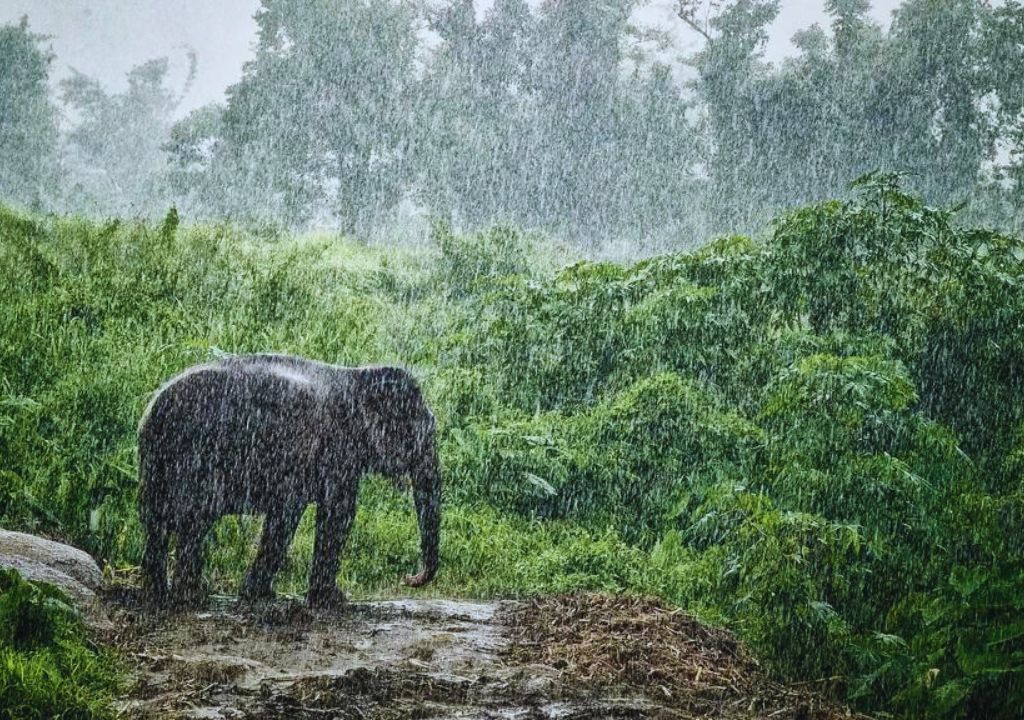Nestled in the picturesque landscapes of Uttarakhand, India, the Rajaji Tiger Reserve stands as a testament to the country’s commitment to wildlife conservation. Spanning across the districts of Haridwar, Dehradun, and Pauri Garhwal, this reserve is not just a sanctuary for the majestic Bengal tigers but also a haven for a diverse array of flora and fauna. While many adventurers opt for safaris during the dry season, there’s a unique charm to embarking on a Monsoon Safari in Rajaji Tiger Reserve, offering an unparalleled experience of witnessing nature in its full splendor.
The Monsoon Magic
As the monsoon clouds roll over the hills, transforming the landscape into a lush green paradise, Rajaji Tiger Reserve comes alive with renewed vigor. The parched earth eagerly absorbs the rain, giving rise to many vibrant foliage and blooming flowers. The gentle pitter-patter of raindrops against the leaves creates a soothing symphony that accompanies you throughout your safari journey.

Wildlife Encounters
Contrary to popular belief, the rainy season doesn’t deter wildlife sightings; instead, it offers a different perspective on the reserve’s inhabitants. The rejuvenated vegetation provides ample grazing opportunities for herbivores like elephants, deer, and wild boars, making it easier to spot them as they roam freely searching for food. Additionally, the increased water sources during this time attract various avian species, delighting birdwatchers with their colorful plumage and melodious calls.
Tiger Tales
While spotting the elusive Bengal tiger is always a matter of luck and timing, the rainy season presents a unique opportunity for tiger enthusiasts. With the vegetation lush and dense, tigers often venture out of their secluded habitats in search of prey, increasing the chances of a thrilling encounter. However, even if the majestic feline remains elusive, the signs of its presence, such as pugmarks and scratch marks on trees, serve as a reminder of the wild beauty that lies within the reserve.

Safari Experiences
Embarking on a rainy season safari in Rajaji Tiger Reserve is a sensory delight. The cool breeze carries the earthy scent of wet soil, invigorating your senses as you traverse through the rugged terrain. The experienced guides and naturalists accompanying you on the safari provide invaluable insights into the reserve’s ecology, enriching your understanding of its intricate ecosystem. Whether you opt for a jeep safari or choose to explore on foot, each moment spent in the wilderness leaves an indelible mark on your soul.
Monsoon Safari timings
Morning Safaris
Typically, morning safaris in Rajaji National Park during the Monsoon Safari season start early to take advantage of the cooler temperatures and increased wildlife activity. Timings can vary depending on park regulations and weather conditions, but they often begin around dawn, usually between 6:00 AM to 7:00 AM.
Afternoon Safaris
Afternoon safaris provide another opportunity to explore the park’s diverse ecosystems and encounter its inhabitants. These safaris usually commence in the late afternoon, allowing visitors to witness the transition from day to night and observe nocturnal animals as they become active. The timing for afternoon safaris can range from 2:00 PM to 4:00 PM, depending on park regulations and sunset times.
Duration of Safaris
The duration of safaris in Rajaji National Park varies depending on the type of safari and park regulations. Morning safaris typically last around 3 to 4 hours, while afternoon safaris may have a similar duration, allowing visitors ample time to explore the park’s wilderness and wildlife habitats.
Conservation Efforts
Beyond the thrill of wildlife sightings, a rainy season safari in Rajaji Tiger Reserve also highlights the importance of conservation efforts in preserving our natural heritage. The reserve’s management works tirelessly to maintain the delicate balance between human activities and wildlife habitats, ensuring that future generations can continue to marvel at its beauty. By participating in eco-friendly safaris and adhering to responsible tourism practices, visitors play a crucial role in supporting these conservation initiatives.

Beyond the immediate thrills and sensory delights, a rainy season safari in Rajaji Tiger Reserve offers a deeper connection to the rhythms of nature. It’s a chance to witness the circle of life in action, as animals seek shelter from the rain, birds take flight in the damp air, and plants burst forth with renewed vitality. In this dynamic ecosystem, every drop of rain plays a vital role in sustaining life, reminding us of our interconnectedness with the natural world.
Moreover, exploring the reserve during the rainy season provides a unique perspective on its landscapes. The Monsoon Safari transforms the rugged terrain into a tapestry of greens, with cascading waterfalls, glistening streams, and mist-shrouded valleys adding to the ethereal beauty of the surroundings. For photographers and nature enthusiasts alike, the rainy season presents endless opportunities to capture the reserve’s enchanting vistas in all their glory.
Tips for a Monsoon Safari in Rajaji Tiger Reserve

However, it’s essential to acknowledge the challenges and considerations that come with visiting Rajaji Tiger Reserve during the rainy season. Heavy rainfall can sometimes lead to road closures or restricted access to certain areas of the reserve for safety reasons. Therefore, it’s advisable to check weather forecasts and road conditions before planning your safari and to be prepared for unexpected changes in your itinerary.
Additionally, while the rainy season enhances wildlife sightings in many ways, dense vegetation and limited visibility can also pose challenges for spotting elusive creatures such as tigers and leopards. Patience and perseverance are key virtues for safari-goers, as nature often reveals its secrets at its own pace.
Memorable Monsoon Safari
Pack Accordingly
Make sure to pack waterproof clothing, sturdy footwear, and protective gear for your electronic devices to stay dry during the safari. Don’t forget insect repellent and sunscreen, as the rain can bring out mosquitoes, and the sun may peek through the clouds unexpectedly.

Choose the Right Vehicle
Opt for a safari vehicle with a covered roof to shield you from the rain while still allowing for excellent wildlife viewing. Open jeeps with canvas covers are a popular choice, offering both protection and flexibility for photography.
Listen to Your Guide

The experienced guides and naturalists accompanying you on the safari are invaluable resources. Listen to their insights, follow their instructions, and ask questions to enhance your understanding of the reserve’s ecology and wildlife behavior.
Be Patient and Observant
Wildlife sightings in the rain may require patience and keen observation skills. Keep your eyes peeled for movement in the undergrowth, listen for animal calls, and scan the surroundings carefully for signs of wildlife activity.
Respect Wildlife and Habitat
Remember that you are a guest in the animals’ home. Maintain a respectful distance, avoid making loud noises or sudden movements, and never feed or attempt to approach wild animals. Leave no trace of your presence and adhere to park regulations to minimize your impact on the environment.

Embrace the Experience
Embrace the unpredictability of nature and the unique challenges posed by the rainy season. Instead of focusing solely on wildlife sightings, immerse yourself in the sights, sounds, and sensations of the rain-drenched landscape, allowing yourself to connect with the essence of the wild.
Conclusion
A Monsoon Safari in Rajaji Tiger Reserve is more than just a wildlife excursion; it’s a journey of self-discovery amidst nature’s bountiful treasures. From the rhythmic patter of raindrops to the awe-inspiring sight of a tiger prowling through the verdant undergrowth, every moment spent in the reserve is a testament to the enduring allure of the wild. So, pack your bags, don your rain gear, and embark on the adventure of a lifetime as you explore the untamed beauty of Rajaji Tiger Reserve in the rainy season.

FAQs About Monsoon Safari in Rajaji
1. Is it safe to go on a safari during the rainy season?
While safaris during the rainy season can be a unique and rewarding experience, it’s essential to prioritize safety. Choose a reputable tour operator that adheres to safety protocols and follows park regulations. Additionally, be prepared for changing weather conditions and road closures due to heavy rainfall. Always listen to the guidance of your safari guide and follow their instructions for a safe and enjoyable experience.
2. Will I still be able to see wildlife during the rainy season?
Yes, wildlife sightings are still possible during the rainy season, and in some cases, even more likely due to increased water sources and lush vegetation. However, dense foliage and limited visibility may pose challenges for spotting certain species. Patience, keen observation skills, and the expertise of your safari guide are key to maximizing wildlife encounters during the rainy season.
3. What should I wear and pack for a Monsoon Safari?
It’s essential to pack waterproof clothing, including a rain jacket, pants, and sturdy footwear. Additionally, bring along protective gear for your electronic devices, such as waterproof cases or bags. Don’t forget essentials like insect repellent, sunscreen, and a hat to shield yourself from the elements. A pair of binoculars and a camera with weather-sealed features can also enhance your safari experience.
4. How does the rainy season affect safari logistics and accessibility?
Heavy rainfall can sometimes lead to road closures or restricted access to certain areas of the reserve for safety reasons. It’s advisable to check weather forecasts and road conditions before planning your safari and to be prepared for unexpected changes in your itinerary. Choosing a safari vehicle with a covered roof can protect from the rain while still allowing for excellent wildlife viewing.
5. Are there any special considerations for photography during the rainy season?
Photography during the rainy season can yield stunning results, capturing the vibrant colors and dramatic landscapes of the reserve. However, it’s essential to protect your camera gear from moisture using waterproof covers or bags. Keep a lens cloth handy to wipe away raindrops, and experiment with creative compositions to make the most of the atmospheric conditions.

